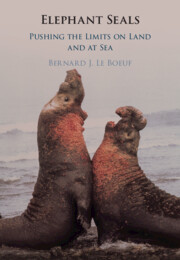Book contents
- Elephant Seals
- Elephant Seals
- Copyright page
- Contents
- Preface
- Acknowledgments
- 1 Origins, Misnomers, and Bottleneck
- 2 Back from the Abyss, Population Recovery, and Genetic Aftermath
- 3 The Year of the Seal
- 4 Fieldwork 101
- 5 Adapting to Life at Sea and on Land
- 6 The Cost of Living in a Seal Harem
- 7 Coito Ergo Sum
- 8 Females
- 9 Diving, Foraging, and Migration
- 10 Development
- 11 Sleep When You Can
- 12 What Is All the Noise About?
- 13 Comparisons, Unsolved Mysteries, and Conclusions
- References
- Index
- Plate Section (PDF Only)
8 - Females
Designed to Reproduce
Published online by Cambridge University Press: 23 September 2021
- Elephant Seals
- Elephant Seals
- Copyright page
- Contents
- Preface
- Acknowledgments
- 1 Origins, Misnomers, and Bottleneck
- 2 Back from the Abyss, Population Recovery, and Genetic Aftermath
- 3 The Year of the Seal
- 4 Fieldwork 101
- 5 Adapting to Life at Sea and on Land
- 6 The Cost of Living in a Seal Harem
- 7 Coito Ergo Sum
- 8 Females
- 9 Diving, Foraging, and Migration
- 10 Development
- 11 Sleep When You Can
- 12 What Is All the Noise About?
- 13 Comparisons, Unsolved Mysteries, and Conclusions
- References
- Index
- Plate Section (PDF Only)
Summary
Females are designed to reproduce, and mating is a small part of the process. Females that are most productive breed early in life, at every opportunity (annually), live long, and wean large pups that are most likely to survive and reproduce. These supermoms are rare but have the greatest influence on the next generations. In contrast, most female weanlings (75%) die before reaching breeding age, and most that survive to breed do so only a few times. Long-lived supermoms live up to age 23 and may produce 20 pups in life.
Keywords
- Type
- Chapter
- Information
- Elephant SealsPushing the Limits on Land and at Sea, pp. 80 - 98Publisher: Cambridge University PressPrint publication year: 2021

